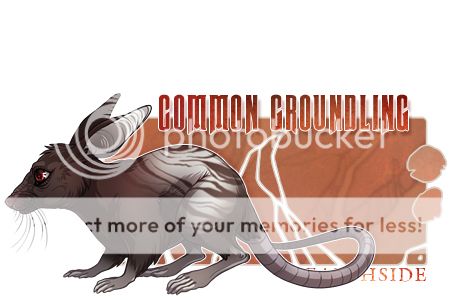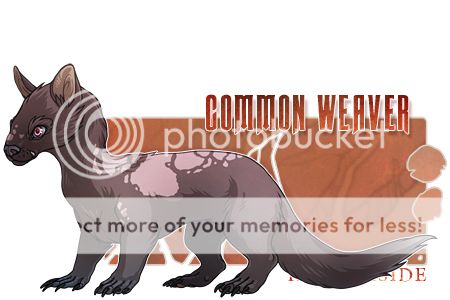|
|
|
|
|
|
|
|
|
 Posted: Fri Dec 27, 2013 4:17 pm Posted: Fri Dec 27, 2013 4:17 pm
 This is the master-thread for all things Sentinel, Familiar, and Lore related. The majority of this thread will link to sub-threads within the Archives. Table of Contents: I. Sentinel Physiology & Behaviour II. Sentinel Lore & Mythology III. Familiar Species IV. Flora & Fauna of Hearthside
|
 |
 |
|
|
|
|
|
|
|
|
|
|
|
|
 Posted: Wed Jan 01, 2014 10:41 am Posted: Wed Jan 01, 2014 10:41 am
[ SENTINEL PHYSIOLOGY & BEHAVIOUR ] I. Biology & Morphology:
It is unknown from which evolutionary line Sentinels branched, but it is suspected they are at least partly related to monitor lizards of South Asia. They are slightly smaller than their suspected ancestors, with mature females reaching 2 meters in length and 80 kg in weight and males reaching 1.5 meters and 60 kg. Most unusual is the evolution of a shifted and more shock absorbent skeletal frame, which allows bipedal standing and walking for many hours.
Sentinels are developed to live in extreme heat climates such as Hearthside and are not well equipped if temperatures drop severely. Their scales are small, smooth, and reflective, with little gaps between units, forming a seamless hide that insulates from heat and traps moisture. The pseudo-fur on their necks and lower back serve as cooling mechanisms by mediating heat and water release from the Sentinel’s body. Their feet are padded with thick, sensitive skin able to withstand the scorching heat of baking earth.
Unlike its ancestor, the Sentinel does not have a forked tongue. Rather, it has developed a flat, almost spoon-like tip, which it uses to chemically scent the air. It mimics the appearance of a protrusion found on the end of the Sentinel’s tail, which has been likened to the lamellae on gecko toes. Although the suction-cup-like disc appears to be mostly vestigial, some Sentinels, particularly those that live in the Cliffs, use it to aid with balancing on vertical surfaces.
In addition to a highly developed sense of smell, Sentinels have excellent night vision and adaptable day vision due to their quadrated eyes. Sentinels are primarily crepuscular, although many will modify their sleeping rhythms to match their prey. Few Sentinels are active at the peak of the day, for the heat drains most species of their energy.
Sentinels are carnivorous, consisting almost exclusively on raw meat, although they can be found foraging for insects when food is scarce. They can gorge up to their body weight in meat in a single sitting and can go up to three months without food by storing protein deposits in their thick, muscular tails. Sentinels on a starvation cycle often have much thinner tails compared to well-fed brethren, as they digest through their tail reservoirs.
II. Intelligence & Social Behaviour:
Sentinels are far more intelligent than would seem evolutionarily feasible, with large brains with highly developed emotional and memory centers. They are adaptive learners, instinctually mimicking behaviours as hatchlings and observing and incorporating behaviours into adulthood. Although their vocal chords are not developed for ranged notes, Sentinels have developed a complex language consisting of vocal cues and nonverbal movement. Rhythmic variations of warbles, hisses, and croaks combined with subtle body movements lends to forms of communication as complicated as some past human tongues.
Furthermore, the evolution of extremely flexible digits allows Sentinels to do something not seen since humans: craft. Because their fingers are almost as versatile as human hands, Sentinels can and have been seen making rudimentary baubles and hunting accessories, wearing pelts of prey and collecting metal and bone fragments as jewellery. Some nomadic Sentinels have seen fit to tout themselves as artisans and crafters, hunting for prey not by running them down and devouring them, but by bartering for them with other Sentinels.
Despite their developed limbic system, most Sentinels are not true pack-dependent animals. Although many can and do form familial and romantic attachments, most packs formed are mission-oriented, and alliances are swift to make and break. Few Sentinels are solitary, however; the death risk is too great in Hearthside to remain alone for long.
As developed carnivores near the top of Hearthside’s food pyramid, Sentinels can be highly territorial and will often defend prime hunting and nesting locations to the death. They do realise, however, that commonly frequented locations are too travelled to defend easily. Territories will often overlap if hunting is scarce, and common migration paths such as the Riverpath and entrance to the Northern Cliffs are, by unspoken rule, unclaimed.
III. Maturation & Breeding Behaviour:
Sentinels are viviparous and give birth to between 2 – 4 children per breeding cycle. Babies will gestate inside the mother for eight weeks. Hatchlings are no bigger than 30 cm, and are extremely vulnerable at birth, having little fur cover and soft scales. Mothers will usually, but not always, stay with hatchlings until adolescence, at which point they are referred to as juveniles and can be approximately 1 m in length.
As Sentinels are highly intelligent and adaptive learners, mother-child bonding behaviour is often passed between generations; a coddled mother will likely coddle her children, while a mother left in her adolescence is also likely to leave her children when they are juveniles.
In-thread, a hatchling will mature to a juvenile within 1 – 2 weeks, whereas a juvenile matures to an adult in 2 – 3 weeks. In verse, however, hatchlings will harden and grow within six months to juveniles. Although still sexually immature, juveniles are old enough to mimic and learn behaviours from their parents, and can hunt smaller prey for themselves. Sentinels will reach sexual maturity (and adulthood) when they are three years old, and will live up to 30 – 40 years of age.
|
 |
 |
|
|
|
|
|
|
|
|
|
|
|
|
|
|
|
 Posted: Wed Jan 01, 2014 11:14 am Posted: Wed Jan 01, 2014 11:14 am
[ SENTINEL LORE & MYTHOLOGY ] I. Sentinel History:
Many, many thousands of years ago, a series of cataclysmic events destroyed the majority of life on Earth, as well as permanently warping the atmosphere and climate into a Fire Age that would last for centuries. Over time, the creatures that survived evolved to adapt to an Earth that was far hotter, bleaker, and more dangerous than had existed before. The Sentinels' lore calls the apocalyptic event the Splinter, naming an alien hatred that destroyed the land from within, erupting volcanoes and splitting continents:
Many eons ago, a splinter in the crust of the world burrowed itself into the center of the world and festered and festered, until at last its hot, burning hate spilled through the wound it had made and erupted out of the earth. Its rage, violent and ruined for reparation, boiled the waters and turned the skies into ash that would melt the breath of all living creatures. Such was the splinter's rage that the rain of fire and ash lasted thousands of years, until only the smallest of creatures survived, hiding in the pockets of earth that the splinter could not see. But even fire and hate could not last an eternity, and so the splinter in the center of the world cooled and slowed. The waters calmed, and although the sky remained dark and bleak, the burning winds began to clear and the earth, at last, was still.
First, the grass returned. The most proliferous of plants grew tentative shoots on the barren remains of what once had been the world, and, as no fire came to them, painted the red land gold and green. Then came the insects and small rodents, and then the ancient trees long unseen until the searing hate of the splinter cracked open long-awaiting seeds. Then came the low-flying birds, and the predators after them, and at last awoke a creature most susceptible to the fire and ash and writhing rage - us, the Sentinels of the Hearth.
II. Sentinel Spirituality:
Modern Sentinels are a godless species, adhering to no strict religion or spiritual system beyond the power of their own mind and claws. However, many older Sentinels subscribe to a personal spirituality stemming from their tumultuous relationship with the Hearth. No one knows if any of the lore is true, but the divide exists between the younger generations who scoff at the Hearth being more than a fissure in the earth, and the older generations, who believe in the return of the Splinter.
Sentinel spirituality is highly personal and often passed familially through generations of oral teachings. Regardless of variations between families, all Sentinel lore is centered on the events of the Splinter, the rise of the Hearth, and what the collective soul known as the Wounded Earth.
The Wounded Earth is how older Sentinels refer to the land post-Splinter – an Earth hurt and ravaged by the events of the Splinter, healing slowly but still vulnerable. The Earth is a collection of spiritual embodiments of geographic locations and elemental symbols, each with a particular history and relationship to the Splinter. The three most dominant elements in Sentinel lore are Magma (Rebirth), Ash (Death), and Wind (Breath).
III. Sentinel Lore:
Sentinel lore is a collection of tales and oral traditions dating far back to beginning of the settlement of the Hearth. Please click on the links below to visit individual tales.
|
 |
 |
|
|
|
|
|
|
|
|
|
|
|
|
 Posted: Fri Jan 17, 2014 10:00 pm Posted: Fri Jan 17, 2014 10:00 pm
[ FAMILIAR SPECIES ] Familiar species are natives to Hearthside; however, they exhibit sentience beyond their related kin species. Familiar species are fully roleplayable as individuals, and do not need to be "owned" by Sentinels, although Sentinels do occasionally take species as pets or hunting partners.  I. The Groundling:Rarity: Common.
Average Lifespan: 3 - 5 years, fully developed.
Average Size: 10 - 12 inches in body and another 8 - 10 inches in tail. A Groundling's body is slightly shorter than the length of a Sentinel's head.
Habitats: Found everywhere except the Shifting Desert and the Hearth.
Description: Like their evolutionary ancestor the brown rat, Groundlings are small, highly adaptable, and voracious eaters. They are by far the most common companion species in Hearthside, found everywhere west of the Hearth. Although they function well alone, most Groundlings form large colonies in caverns and burrows in the ground. They are true omnivores, and will consume anything they can find. Although they are numerous and the size of a small hare, Groundlings often make miserable prey for Sentinels due to their instinct for defensive swarming when attacked.
II. The Weaver:Rarity: Common.
Average Lifespan: 6 - 10 years, fully developed.
Average Size: 20 - 25 inches including tail. A weaver's body is approximately the length of an average Sentinel's arm.
Habitats: Most common at the Northern Cliffs and Hunterlands; occasionally found at the Winddroves.
Description: Weavers are so named for their long, sinuous bodies and for their ability to "weave" through self-made networks of underground tunnels. They use their wide, modified paws to dig into soft earth and form large, root-like underground tunnels. Unlike the swarming behaviour of Groundlings, Weavers form medium-sized family groups that nest in the same territory for generations. Weavers are primarily insectivores and therefore can make too-stringy meat for picky Sentinels.
|
 |
 |
|
|
|
|
|
|
|
|
|
 |
|
|
|
|
|
|




